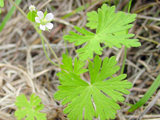Native Plants

Q. Who is Mr. Smarty Plants?
A: There are those who suspect Wildflower Center volunteers are the culpable and capable culprits. Yet, others think staff members play some, albeit small, role. You can torture us with your plant questions, but we will never reveal the Green Guru's secret identity.
Did you know you can access the Native Plant Information Network with your web-enabled smartphone?
Ask Mr. Smarty Plants is a free service provided by the staff and volunteers at the Lady Bird Johnson Wildflower Center.

rate this answer
Wednesday - January 16, 2008
From: Milford, CT
Region: Northeast
Topic: Wildflowers
Title: The most common wildflower in North America
Answered by: Nan Hampton and Joe Marcus
QUESTION:
Hi Mr. Smartyplants, What the most common wildflower in North America? My friend thinks it's the oxeye daisy. Is this correct? I work for a puzzle publishing company, and am doing research for a themed puzzle. The puzzle is about wildflowers. Hope you can help! Debra in Milford, CTANSWER:
The answer depends on how you define the terms, "common" and "wildflower." Many of the most "common wildflowers"—that is, species commonly called wildflowers and occurring in all 48 contiguous states—are of Old World origin. Many are also considered weeds. Among them are Oxeye daisy (Leucanthemum vulgare), Bull thistle (Cirsium vulgare), Bachelor's buttons (Centaurea cyanus), Queen Anne's-lace (Daucus carota), Henbit (Lamium amplexicaule), Dandelion (Taraxacum officinale) and Shepherd's purse (Capsella bursa-pastoris) that all came from Europe or Asia.
Native candidates that occur in all the "lower 48 states" (though all are not native to every state) are Common yarrow (Achillea millefolium), Carolina Crane's-bill (Geranium carolinianum), and Sleepy catchfly (Silene antirrhina).
For our money, however, the two most common wildflowers (herbaceous native plants with showy flowers) are Blackeyed Susan (Rudbeckia hirta) and Common sunflower (Helianthus annuus). Both occur all across America and in many places occur in vast numbers.
Good luck with your puzzle and we hope it includes lots of native wildflowers.
More Wildflowers Questions
Bluebonnets for wedding centerpieces in Ft. Worth
April 14, 2009 - I am looking to purchase 25 live bluebonnet plants for my wedding centerpieces. I need them by May 15, 2009. Do you sell them?
view the full question and answer
Summer-blooming Wildflowers for Wichita Falls, TX
June 08, 2013 - Can you give me a list of some summer-blooming (June, July, August, maybe September) wildflowers that I can plant in my flower beds in Wichita Falls, TX and tell me when the best time is to sow the se...
view the full question and answer
Alternative names for Aquilegia Sanguinaria
May 03, 2006 - I am looking for the common name for a flower called Aquilegia Sanguinaria. Can you help? Does this even exist?
view the full question and answer
Perennials for Sandy Shade in California
December 17, 2015 - Are there any native perennials that would do well in sandy shade? I have a difficult corner in my garden that does not get much sun. The soil is sandy though I have added some amount of compost to en...
view the full question and answer
Bluebonnet peak for 2010
January 14, 2010 - What does 2010 look for bluebonnets in Texas. When will they peak?
view the full question and answer
| Support the Wildflower Center by Donating Online or Becoming a Member today. |

